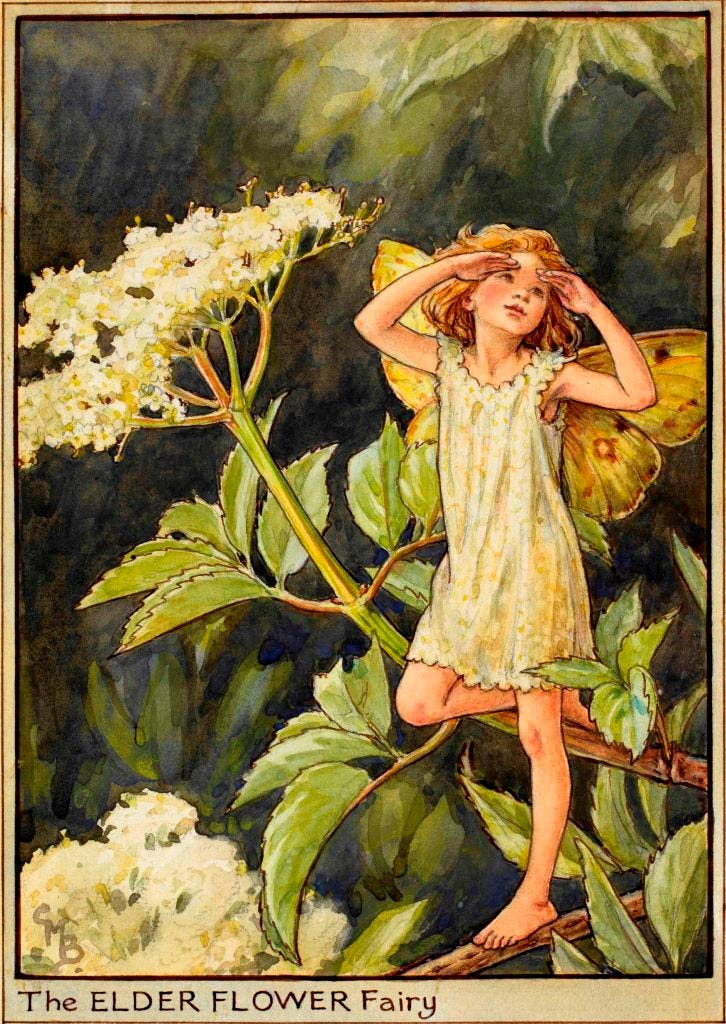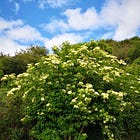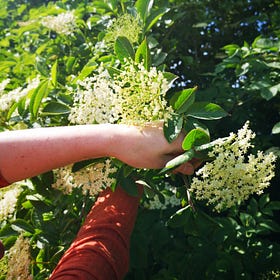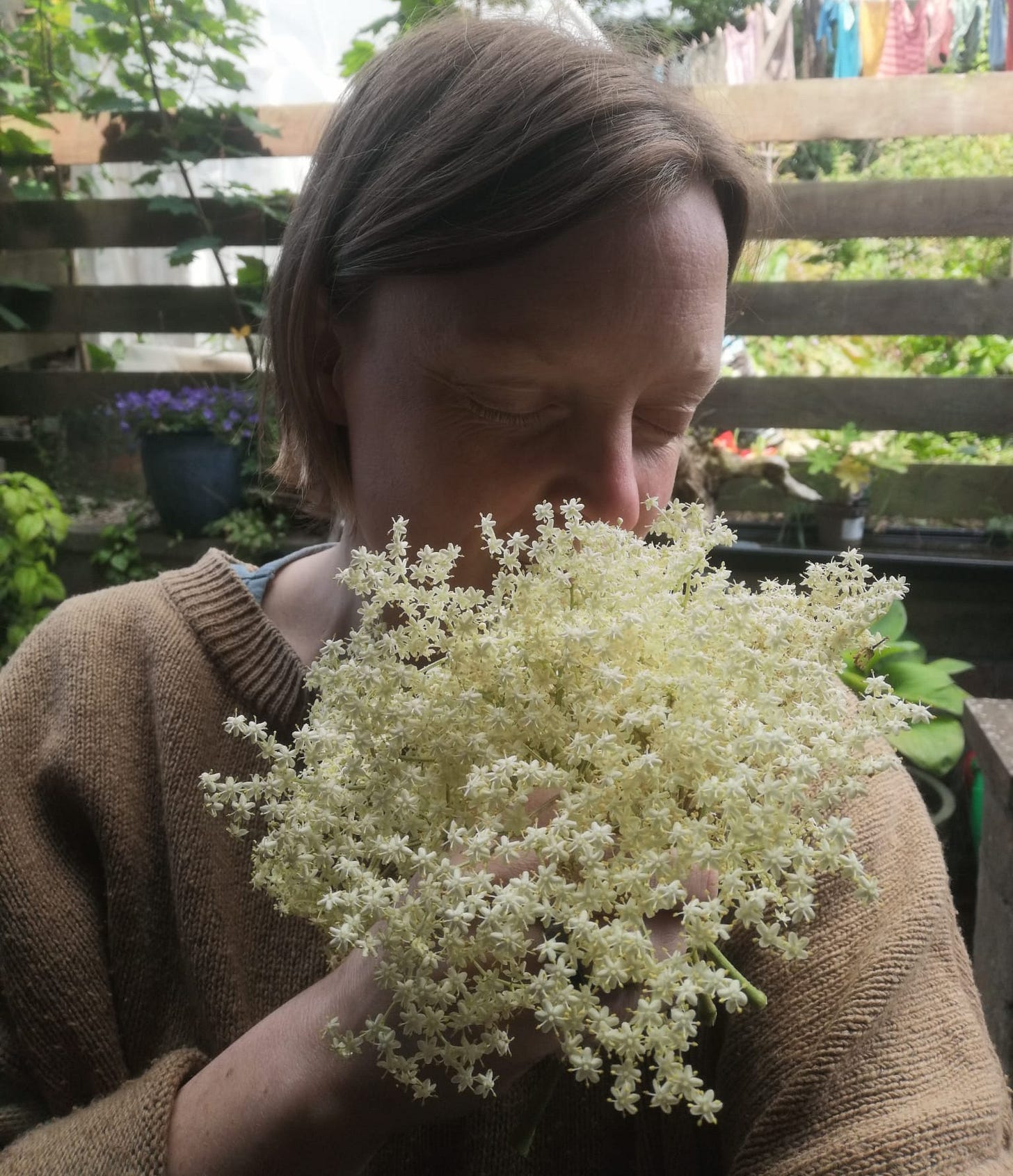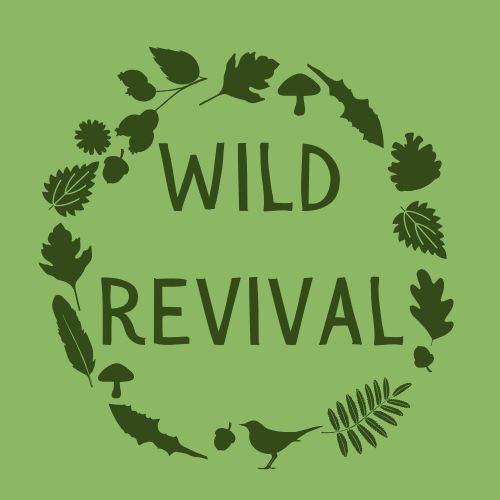Welcome to Wild Notes, my monthly letter to everyone following Wild Revival. I’m Jo, a forager and creative who finds both relief and inspiration in Nature, and this publication is where I share my seasonal noticings and plant wisdom with you. Think of it as a gentle prompt to get outside and interact with Nature in a way that feels nourishing to you. I’m so glad you’re here!
Hello Wild Ones,
As I sit down to write this, I’m interrupted again by the sound of rain on the window and I abandon the laptop to dash outside and gather in the almost-dry laundry. I’ve been in the garden today, pottering about, reading my foraging books for inspiration, and picking flowers to dry for teas. Sunny mornings are the best time to harvest flowers, and as it’s been windy and showery in Northumberland this week, I jumped to the task of drying flowers today before the rain washed away the pollen on the Elderflowers and sogged the Rose petals.
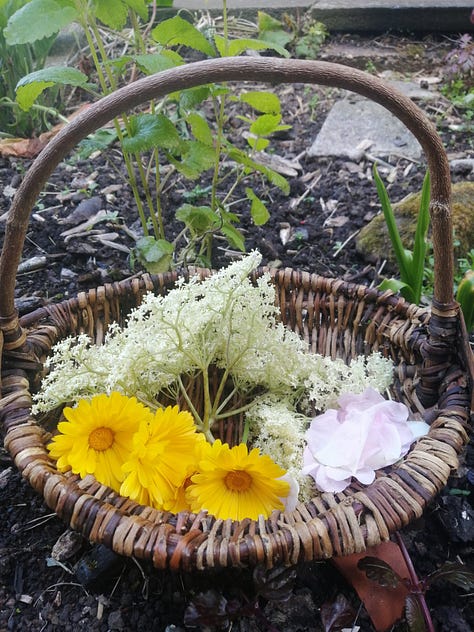
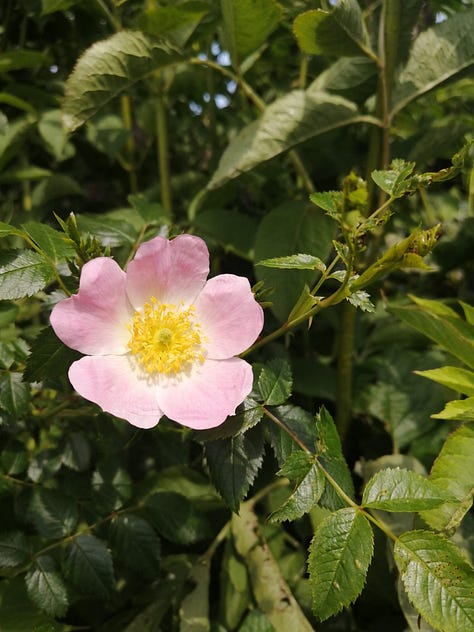
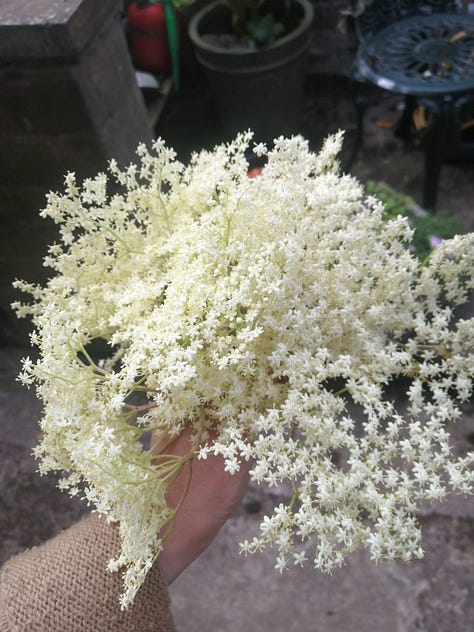
I invested in a dehydrator in couple of years ago and it’s wonderful when you want to dry a lot of herbs for tea and to store, but you can dry flowers easily by placing them upside-down on a plate or tray in a warm room for a few days. The main thing you need is air circulation, so turning the flowers and giving them plenty of room helps to dry them. It’s lovely to extend the season of flowering plants by drying them, and makes my cupboard look so witchy!
I also read this week that smelling flowers amps up our parasympathetic nervous system response - our rest state. You may already know that looking at green plants and trees soothes our brains and relaxes our bodies, but smelling the fragrance of flowers has an even more powerful effect on us. Our animal bodies are wired to be in-tune with Nature and her seasons; the sound of thunder stimulates alertness so we can find shelter, the lower light levels of dusk prepare our minds for sleep, and the scent of flowers triggers a dopamine and serotonin release in our brains, making us feel happy and satiated. So, on your walks to work or with the dog, on your run or when you sit in the garden, smell the flowers like noone is watching. Especially if someone is watching!
The Elder Fairy
By Cicely Mary Barker - visit the Flower Fairy website here.
When the days have grown in length,
When the sun has greater power,
Shining in his noonday strength;
When the Elder Tree’s in flower;
When each shady kind of place
By the stream and up the lane,
Shows its mass of creamy lace—
Summer’s really come again!
I adored the Flower Fairies when I was growing up, and I found this lovely poem about the Elderflower Fairy - the flower that sums up June for me! I wrote about Elderflowers last year so click through to read even more, if you’re curious about this magical tree and Midsummer:
Elderflowers for medicine
Why connect to Elder at all? Apart from tasting wonderfully delicate and florally sweet, the flowers have much to offer us in terms of medicinal support. Here are some of the benefits of Elderflower to our bodies:
Antiviral - teas and tinctures of the flowers help to lessen the symptoms of colds and flu, and particularly chest infections and breathing issues. It can help promote sweating to get rid of the virus and flush your system, while also soothing sore throats. Hot Elderflower tea before bed at the start of a cold can help ward it off, especially powerful when mixed with Yarrow and Mint.
Anti-inflammatory - particularly helpful for sinus problems and swelling of the sinuses and lymph nodes, during viruses and also for allergies. I’ve used Elderflower tincture and tea for years to lessen my Spring and Summer allergies, and recommend combining with Nettle for hayfever and sinusitis. These two herbs are both natural antihistamines, Elderflower containing quercetin which reduces the histamine the body produces. Elderflower also acts as an anti-inflammatory on joints, so can be useful for arthritis and other conditions.
Mild nervine - Elderflower has a gently soothing effect on our nervous systems, can help relieve stress, headaches and general symptoms of pain. I find her incredibly supportive in any tea blend, boosting the other herbs and energetically creating a channel and amplifying the intention. The pleasantly sweet flavour also lifts the taste of herbal tea blends, which is supportive when you feel unwell.
Soothing for skin - beneficial for any skin complaints like eczema, sunburn or sensitivity, especially for pale skin. I find Elderflower preparations reduce redness and balance the skin; cooled Elderflower tea soaked into a cloth makes a wonderful eye compress, especially when suffering from itchy eyes in hayfever season, and I make an Elderflower and Rose petal vinegar to use as a simple face toner. Both plants are astringent and help to tighten and smooth your skin.
Try using Elderflowers!
Make a lovely Elderflower tea by putting 3 or 4 heads into a teapot (or a glass jar loosely covered with a lid) with the largest bits of green stalk removed, as they are bitter. Pour on boiled water and leave for just 2-3 minutes before you pour it. You can sweeten it if you like with honey, or a spoonful of Elderflower Cordial.
Cordial is of course the most familiar preparation for Elderflowers, and if you’re in the Wild Revival membership you get access to my post from last year with my recipe here:
Celebrate with Elderflower
Hello to my subscribers! I hope you saw the last post I just sent out, all about Elder, so have a read of that first. This post is just for my paid members, a special gift, of my recipe for elderflower cordial.
When you join our wild community (which is currently just £5 a month or £50 a year!) you get instant access to all my previous member-only posts, which have wonderful things inside like downloadable ID sheets for wild plants, hedgerow recipe cards and how-tos! This price will shortly be going up, so if you've been on the fence, now is a great time to join us, and lock-in that price.
My last suggestion for today is a wonderfully fun treat - Elderflower Fritters 🌼
These are whole elderflower heads, dipped into batter and fried, with the stalks poking up. You can eat them with a drizzle of honey, a squeeze of lemon juice, or a shake of icing sugar, and they are so moreish!
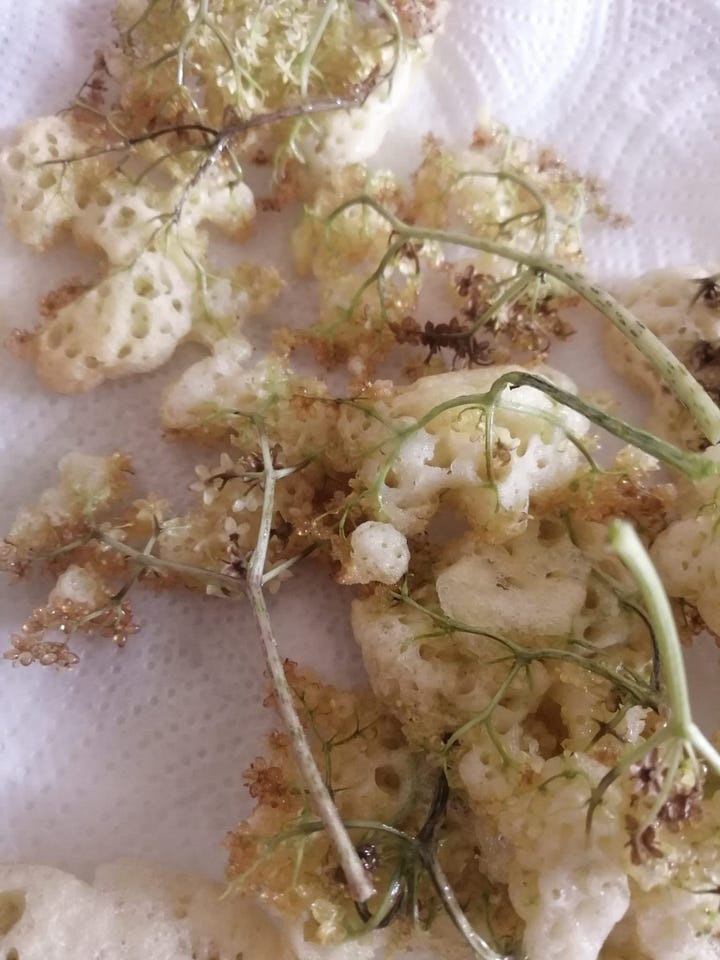
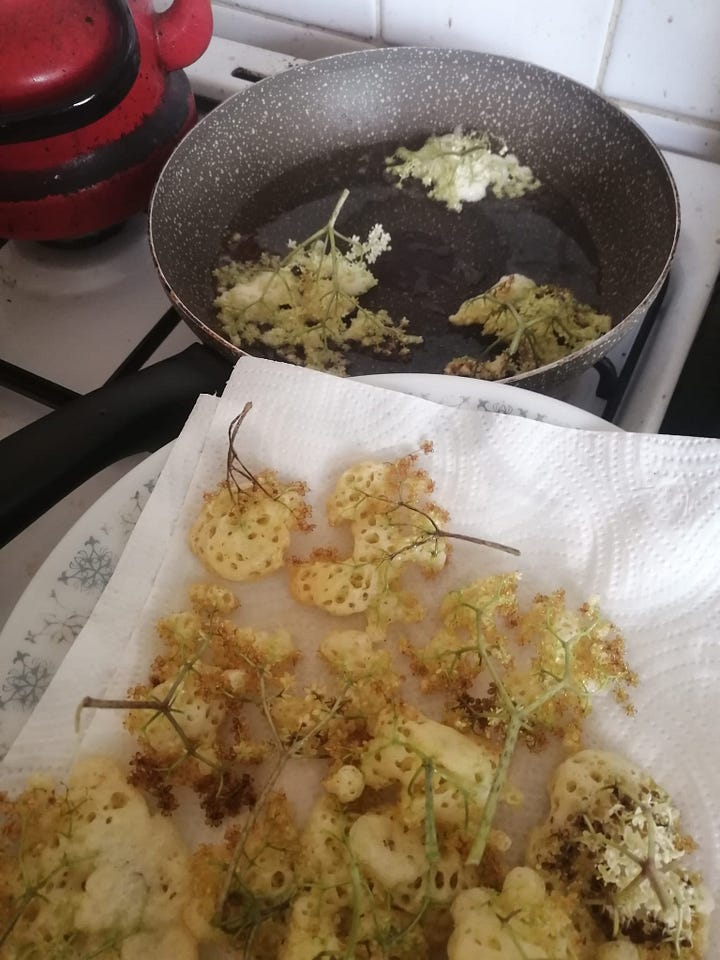
Batter is simple - you can use your go-to pancake batter recipe, or follow my instructions: I whisk 2 tablespoons of GF flour and half a tablespoon of cornflour (gives it crispiness) with one egg and a splash of cold water, until the lumps are gone. I add a pinch of sea salt and a splash more water, whisking and adding water until it’s the consistency of double cream.
I break the big elderflower heads into smaller stalks (there’s about 5 on each huge umbel), dip just the flower tips into the batter and then straight into a hot pan with a layer of sunflower oil in. They’re not exactly deep fried, but I use more oil than I do for usual frying. Have a plate on hand with 2 layers of kitchen paper, and when the batter looks all cooked and the edges are turning golden, pull them out by the stalks and leave them on the paper to drain. These are best eaten straight away, so when I’ve made a plateful, I put the remaining batter in the fridge for later or pancakes tomorrow. To eat, you pick them up by the green stalk and bite off the battered flowers, discarding the bitter stem. A bit of a fun foraged party-food!
We will be making Elderflower fritters at Wild Hygge this Sunday - my in-person monthly Nature connection group in Berwick. If you’re local, you can join the WhatsApp group to get the event announcements; click the button below to add yourself to the group chat, and get your monthly reminder to join me outside!
Do let me know if you try making Elderflower tea, cordial or fritters, or anything else, in the comments below! I love to hear from you.
Share Wild Revival with a friend if you think they’d like a monthly letter from the wild plants too 🌿
Enjoy your June, friends! Remember to smell the Roses, the Elderflowers, and all the other blooms you pass.
Jo xxx



